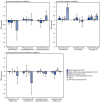Structural and Psychosocial Syndemic Conditions and Condomless Anal Intercourse Among Transgender Women - National HIV Behavioral Surveillance Among Transgender Women, Seven Urban Areas, United States, 2019-2020
- PMID: 38261572
- PMCID: PMC10826687
- DOI: 10.15585/mmwr.su7301a3
Structural and Psychosocial Syndemic Conditions and Condomless Anal Intercourse Among Transgender Women - National HIV Behavioral Surveillance Among Transgender Women, Seven Urban Areas, United States, 2019-2020
Abstract
Psychosocial and structural syndemic conditions, including polydrug use and experiencing homelessness, frequently co-occur and might jointly increase HIV risk. Limited studies have assessed racial and ethnic differences in exposure to syndemic conditions and behaviors associated with HIV transmission among transgender women. This report examines the relation between syndemic conditions and condomless anal intercourse (CAI) among transgender women in seven urban areas in the United States to develop HIV prevention interventions for transgender women. During 2019-2020, transgender women in seven urban areas were recruited using respondent-driven sampling for a biobehavioral survey. Reported syndemic conditions (psychosocial: polydrug use, sexual violence, and psychological distress; structural: homelessness, incarceration, and exchange sex) were summed to create a syndemic score. Using modified Poisson regression to account for RDS, the study assessed whether the strength of the association between syndemic score and CAI differed by race and ethnicity. To assess additive interaction, the relative excess prevalence owing to interaction (REPI) and 95% CIs for selected pairs of syndemic conditions on CAI prevalence stratified by race and ethnicity were estimated. Of 1,348 transgender women (Black = 546, White = 176, and Hispanic = 626), 55% reported CAI; and 24% reported ≥3 syndemic conditions. Reporting additional syndemic conditions was associated with CAI for White, Hispanic, and Black participants. The association was significantly stronger for White than Black and Hispanic participants. Limited significant superadditive interactions were found, although the majority were between structural syndemic conditions. Racial and ethnic differences in REPI estimates were observed. Reporting more syndemic conditions was associated with increased CAI across racial and ethnic groups, demonstrating that HIV prevention efforts for transgender women should address structural and psychosocial syndemic conditions. Results differed by race and ethnicity, indicating that syndemic-focused interventions for transgender women should be tailored to racial and ethnic groups.
Conflict of interest statement
All authors have completed and submitted the International Committee of Medical Journal Editors form for disclosure of potential conflicts of interest. No potential conflicts of interest were disclosed.
Figures



References
-
- CDC. HIV infection, risk, prevention, and testing behaviors among transgender women—National HIV Behavioral Surveillance, 7 U.S. cities, 2019–2020. Atlanta, GA: US Department of Health and Human Services, CDC; 2021.
-
- Brennan J, Kuhns LM, Johnson AK, Belzer M, Wilson EC, Garofalo R; Adolescent Medicine Trials Network for HIV/AIDS Interventions. Syndemic theory and HIV-related risk among young transgender women: the role of multiple, co-occurring health problems and social marginalization. Am J Public Health 2012;102:1751–7. 10.2105/AJPH.2011.300433 - DOI - PMC - PubMed
-
- Mimiaga MJ, Hughto JMW, Biello KB, et al. Longitudinal analysis of syndemic psychosocial problems predicting HIV risk behavior among a multicity prospective cohort of sexually active young transgender women in the United States. J Acquir Immune Defic Syndr 2019;81:184–92. 10.1097/QAI.0000000000002009 - DOI - PMC - PubMed
MeSH terms
LinkOut - more resources
Full Text Sources
Medical
